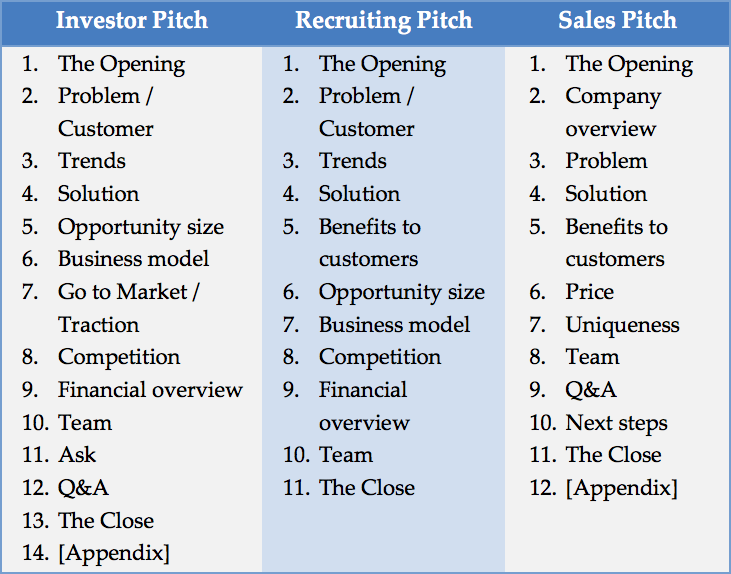Once you have a plan, everything from here on out is sales…
To recruit a team, you need a “pitch.”
To raise money, you need a “pitch.”
To sell your product, you need a “pitch.”
These three pitches provide far more information than the “Elevator Pitch” you created in Step 19. The recruitment pitch explains why the product will sell and why the company is/will be a great place to work. The fundraising pitch explains why the product will sell, why the team can execute, and how the company will make a profit. The sales pitch explains the benefits of the product to the customer and how it will save them time or make them money or other reasons to buy the product.
Each of these pitches is a ten to fifteen slide presentation, presentable in fifteen to twenty minutes.
These three presentations overlap in content but are not identical. When creating each of these presentations, put yourself in the shoes of the audience member and answer the questions they would have. Why should I work there? Why should I invest? Why should I buy? And remember the common theme: “What’s in it for me?”
Two pieces of advice to remember when creating a pitch. First, wrap the pitch around a story. People like to hear a good story far more than they like to listen to a lecture. Tell the story from the perspective of an example customer. Tell about his or her need and how your solution will improve that person’s life. Second, entertain! Make the story interesting. Add suspense. Add humor. Make it memorable.
There are many books on creating a great pitch. The consensus calls for the following topics (with one slide per topic):

Do note that the order of these topics is not set in stone. Some investors have passionately argued that the Team slide should be the second slide. Others say, Opportunity. Some care for details only on the product; some want details on financials. In short, each person you pitch will differ in what they think is the most important part of the pitch. Understand that you can’t satisfy everyone.
For a step-by-step guide on creating and presenting your pitch, read the companion book, The Next Step: A guide to pitching your idea, and then watch the related Next Step class: Lesson 10. A Great Pitch.
Further Reading
The Art of the Start by Guy Kawasaki












